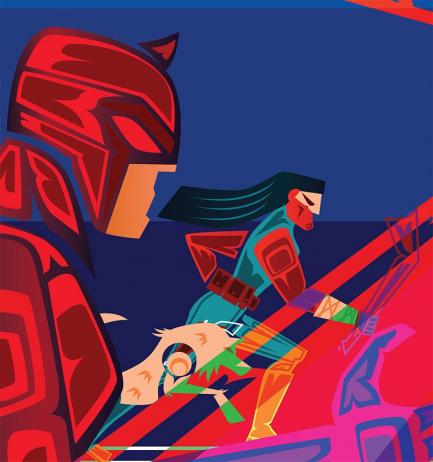Detail featuring Colleen Wing and Misty Knight from "Jeffrey Veregge: Of Gods andHeroes" © 2018 Marvel
Aliens Invade New York City in “Jeffrey Veregge: Of Gods and Heroes”
The location is unambiguous, and the cast of characters is immediately recognizable to Marvel fans: The scene is set in New York City, where Dr. Strange, Colleen Wing, Luke Cage, Misty Knight, Iron Fist, Daredevil, Red Wolf and Lobos, Captain America, Iron Man, Spider Man, Black Widow, Hulk, Captain Marvel, Thor and Ms. Marvel all make an appearance in this race to confront alien invaders. However, in this scene, comic artist Jeffrey Veregge (Port Gamble S’Klallam Tribe) portrays these heroes using traditional tribal motifs and phrases from the S’Klallam language.
“Jeffrey Veregge: Of Gods and Heroes” opens Friday, Oct. 6, at the Smithsonian’s National Museum of the American Indian, George Gustav Heye Center in New York. It will be on view through Oct. 13, 2019.
The Salish (refers to tribes along the Pacific Northwest Coast) graphic designer-turned-comic artist has created a site-specific work featuring a new narrative creation using epic storytelling and grand scale. Veregge’s versions of these characters ask visitors to think about Salish as the protagonists. Who these aliens are is unknown; what is clear is that they present a menacing and outsize presence in the beloved city. The cover text, which translates to “Stories of Suspense,” denotes the unresolved nature of the battle scene that features in the artwork. Veregge is known for his bold blend of the traditional formline style of the Northwest Coast with characters from American pop culture.
In addition to his use of S’Klallam language, the incorporation of the formline style in Veregge’s art affirms his Northwest Coast identity. A design concept that dates back more than 2,000 years, formline uses elongated, slightly flattened ovals and u-shapes with outlines of changing thickness, used in combination to create more elaborate designs. This approach can be found in paintings as well as sculptures, and uses negative space as an important element. Veregge, primarily a graphic artist, studied Salish formline design under master carver David Boxley (Tsimshian), who is particularly well-respected as a totem pole carver. Throughout Veregge’s work, one can see the use of these motifs to define focal points and to create depth and dimension.
“For thousands of years, Native and non-Native storytellers have used art as a means to share the tales of their people,” Veregge said. “For me, I am simply carrying on a tradition that started with my ancestors by using the means of today, and all its modern conveniences, to share the tales that I love. Art evolves, artist tools advance, but the essence of what I do is the same as those who created with the canvases nature provided to tell the stories of gods and heroes long, long ago.”
The National Museum of the American Indian is committed to advancing knowledge and understanding of the Native cultures of the Western Hemisphere—past, present and future—through partnership with Native people and others. The museum’s George Gustav Heye Center is located at One Bowling Green in New York City. For additional information, including hours and directions, visit AmericanIndian.SI.edu. Follow the museum via social media on Facebook, Twitter and Instagram.
# # #
SI-520-2018






